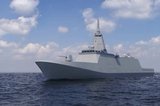SM-3 Block IIA completes second test
The US Navy and the Missile Defense Agency (MDA) have successfully completed the second intercept flight test of Raytheon's Standard Missile-3 (SM-3) Block IIA.
The missile was launched from USS John Finn against a land-launched target resembling an advanced ballistic missile threat.
The next-generation SM-3 Block IIA interceptor is being developed and produced in cooperation with Japanese industry and will be deployable on land as well as at sea. It features larger rocket motors that will allow it to defend broader areas from ballistic missile threats and a larger kinetic warhead. The interceptor’s kinetic warhead has been enhanced, improving search, discrimination, acquisition and tracking functions
Taylor Lawrence, president, Raytheon Missile Systems, said: ‘This second intercept for the SM-3 Block IIA is a success we share with the MDA and the country of Japan, our cooperative development partners. Together, we are building the most advanced solutions for ballistic missile defence.’
Related Equipment in Defence Insight
More from Naval Warfare
-
![NATO tests use of “undetectable, jam-proof” laser communication in maritime scenarios]()
NATO tests use of “undetectable, jam-proof” laser communication in maritime scenarios
As part of its effort to better prepare its capabilities for operations in contested and congested scenarios, NATO evaluated a Lithuanian ship-to-ship terminal designed to not be susceptible to enemy interference.
-
![Future of the Canadian Patrol Submarine Project is still unclear]()
Future of the Canadian Patrol Submarine Project is still unclear
The Canadian government remains tight-lipped on the timeline and funding required for the next steps of its Canadian Submarine Patrol Project, which should offer improved capabilities for the country’s navy.
-
![Mitsubishi eyes future with Australia’s Mogami selection]()
Mitsubishi eyes future with Australia’s Mogami selection
With Australia’s selection of the Mogami-class for Project Sea 3000, Mitsubishi is investigating local production in the next decade as potential export opportunities emerge.
-
![Thales’ new Sonar 76Nano could equip UK Royal Navy on anti-submarine warfare missions]()
Thales’ new Sonar 76Nano could equip UK Royal Navy on anti-submarine warfare missions
The new sonar is designed to equip uncrewed underwater vessels, with the potential to be used by the Royal Navy for its Atlantic Bastion and Atlantic Net missions.























